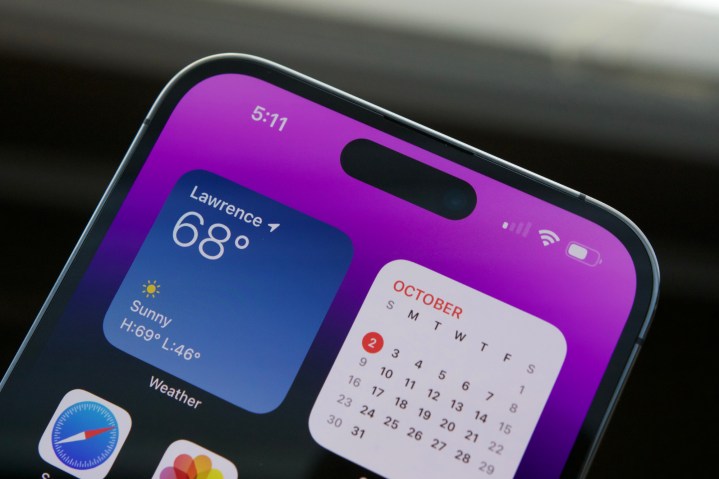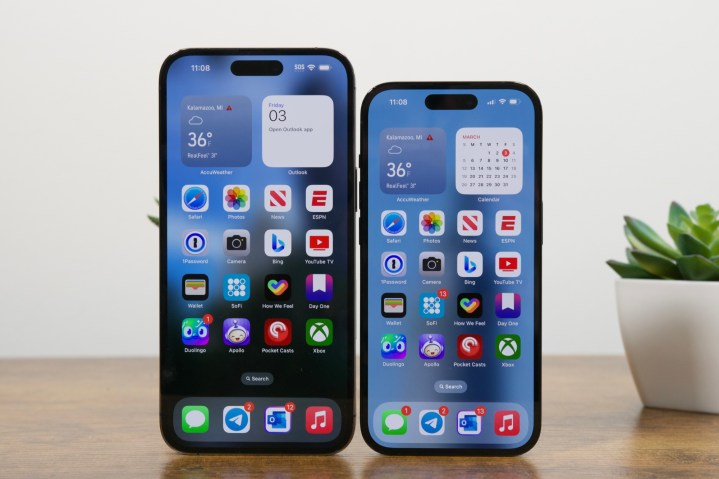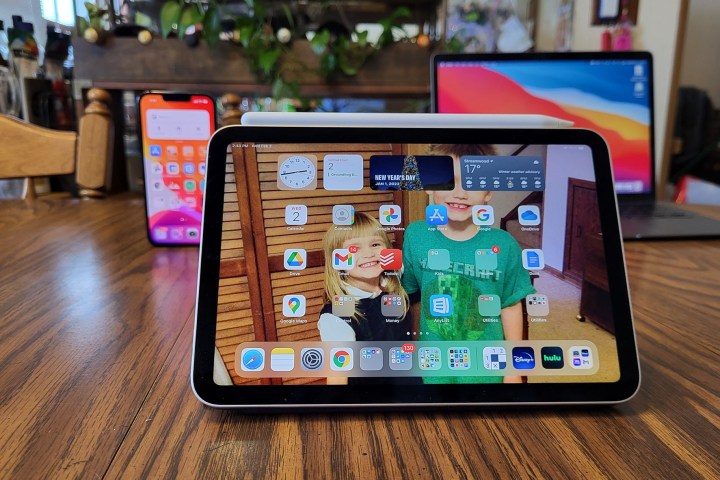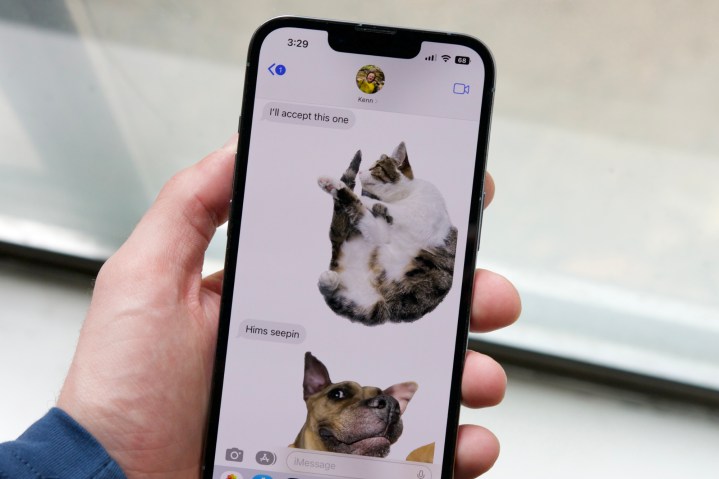Samsung’s Galaxy S23 has arrived to the masses, and it’s one of the best Android phones you can get right now, especially the S23 Ultra. However, for those who don’t need all of the fancy bells and whistles, like the S Pen and 200MP main camera, the regular S23 is also plenty powerful for the average person, especially if you prefer smaller devices.
I’ve been using the Galaxy S23 for the past few weeks, and so far, my experience has been delightful. I know that it’s still early on in the year, but for me, the S23’s small size is perfect and comfortable. Android also does a lot of things better than iOS, like individual volume controls and notifications, for example. But I am still primarily using my iPhone 14 Pro — despite Apple having some big flaws, such as overprocessing images after you capture them.
Here are some reasons why I’m still using my iPhone 14 Pro, despite liking the Galaxy S23 a lot.
Scroll to the top in any app on iOS

When I joined Digital Trends last year, I had to get out of my comfort zone and learn Android after using an iPhone exclusively for over a decade. One of my favorite things about iOS is the ability to jump back to the top of the screen in any app, which is so incredibly handy to have after you lose yourself to infinitely scrolling social media.
I was actually shocked to discover that no such feature exists on Android when I tried to tap the top of the status bar to go back to the top of my Instagram or Facebook feed after scrolling for several minutes. I ended up having to scroll all the way back to the top, which is quite tedious.
I know it’s pretty silly, but tapping the top of the screen to go back to the very top of the app you’re in is such a timesaver. It also feels so natural and intuitive on iOS that I’m really surprised it doesn’t exist on Android. Perhaps it’s something that Google can consider adding in Android 14.
Software elasticity

I’ve been using an iPhone ever since I got the original one as a gift in 2008, so I’ve gone through every single version of iOS there is. And one of the things about iOS that I absolutely love is the elasticity of the operating system itself.
What do I mean by this? Basically, the smooth scrolling and the “bounce” effect that you see with the scrollbar on the side as you reach the end of something. Even the Dynamic Island on the iPhone 14 Pro has subtle, but whimsical little animations when it activates because you swipe out of an app, like Music, especially if your flick leans more toward a certain direction.
But when you use Android, scrolling just suddenly stops once you reach the end — there’s no fun “bounce” to it. Coming from iOS, it is actually pretty jarring. After using iOS for years, it’s the little things like elasticity that make it much more pleasant to use overall.
Seamless integration with other Apple devices

My first iPhone was also my first Apple product, but I’ve since switched to Macs, and I get an iPad and Apple Watch every couple of years. Essentially, all of my tech life over the past decade has been on an Apple device. I’ve also been in the tech journalism industry just as long, and the iPhone’s seamless integration with iPad, Mac, and Apple Watch has made my personal and work life so much easier.
For work, I need to take a lot of screenshots or photos for my articles. Once I make any necessary edits, having the ability to AirDrop my images to my iMac means I can quickly rename them and drop them into WordPress. With my Android phones, I need to do some extra steps like hop into Google Photos, find the images I need, and then download them — still easy, but not as seamless as just sending what I need over.
I also love being able to use the Universal Clipboard to copy and paste text, images, photos, and even video from one Apple device to another through the use of Handoff, which is something I just can’t do with an Android phone.
Those are just some of the biggest examples of how my iPhone easily integrates with all of my other Apple devices, to the point where it’s just an essential part of my workflow. Again, I know that it’s possible to get the stuff I need off my Android phone onto my Mac, but it’s just not as seamless. Plus, there are other perks, like iCloud and iMessage, that tie everything together.
Making it easy to communicate with iMessage

Speaking of iMessage, it’s pretty much my key way to communicate with all of my friends and family, who mostly use iPhones as well. Not only do I have access to iMessage on my iPhone 14 Pro, but I have it on my iPad and Mac, too, with all of my messages in sync. I also like that iMessage lets me send SMS from my computer as well, thanks to text message forwarding on my iPhone.
But the biggest reason I like using my iPhone for iMessage is the fact that I can send full-resolution video clips to other iMessage users. I used to never be a video person, but that changed once I had my daughter. Now, I take at least one video a day of her cute antics, and I love to share that with my family. And iMessage lets me send the video in full resolution to others without having to do anything extra or special.
However, I dislike that whenever I’m sent a video from someone with an Android phone (or vice versa), it ends up super-compressed and pixelated. That’s because it’s sent as an MMS, and all major carriers in the U.S. impose an arbitrary limitation on video file sizes that are sent through MMS. Of course, this could be resolved if Apple were to implement Rich Communication Services (RCS), but that’s a completely separate story.
Still, since most of my family and friends also use an iPhone, having iMessage is the easiest way for me to communicate with them. I would still like to see some way to get around the pixelated video clips with non-iPhone users at some point, but until then, I’ll be sticking with iMessage.
The iPhone has better apps

If using iOS for the past decade has taught me one thing, it’s the fact that, in general, you can find better apps than on Android. A lot of the app developers that I’ve followed throughout the years also exclusively develop for Apple’s platforms as well, including Mac. There’s just something about iOS (and Mac) apps that have a certain level of polish and finesse that you don’t really see on a lot of Android apps.
For example, I previously used Tapbots’ Tweetbot when I was active on Twitter, and now I use their Mastodon app, Ivory, instead. Before Elon Musk killed Tweetbot, it was the only way I could use Twitter, and I never could find the same kind of app experience on Android for that. The same can be said for Ivory, too — there are plenty of Mastodon apps on Android, but Ivory just feels so much more polished and intuitive for me to use.
One of my favorite photo-editing apps on iOS, Darkroom, is also not available on Android (there’s a copycat on the Play Store, but it’s not the same). Even when using cross-platform apps, like 1Password, Facebook/Instagram, etc., the iOS version always feels like it runs smoother and is overall more fun to use.
Apple’s not perfect, but I still like it

Ever since I started to dive into the world of Android devices, I’ve learned that there are definitely areas where Android is superior, and I get that. Notifications actually make sense, volume controls are streamlined, and there are a lot of granular settings to really customize your entire experience.
But Apple’s iOS has a lot of little intricacies in the software that make me still enjoy using it. They may be small, like the jump to the top and elasticity, but these things help make the software delightful to use. Things like iMessage make my life easier, and app experiences feel more refined overall. When you’re using a device all day, things like that do matter.



